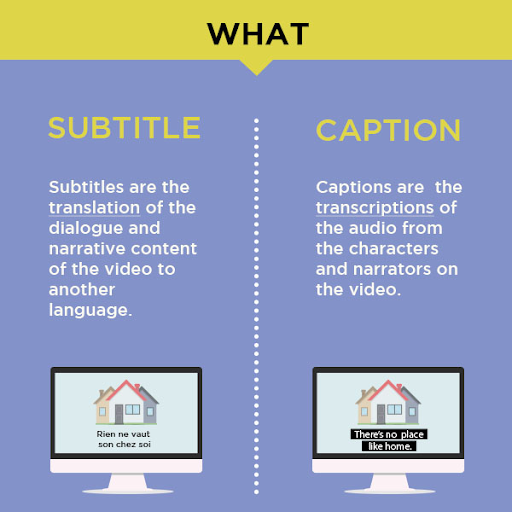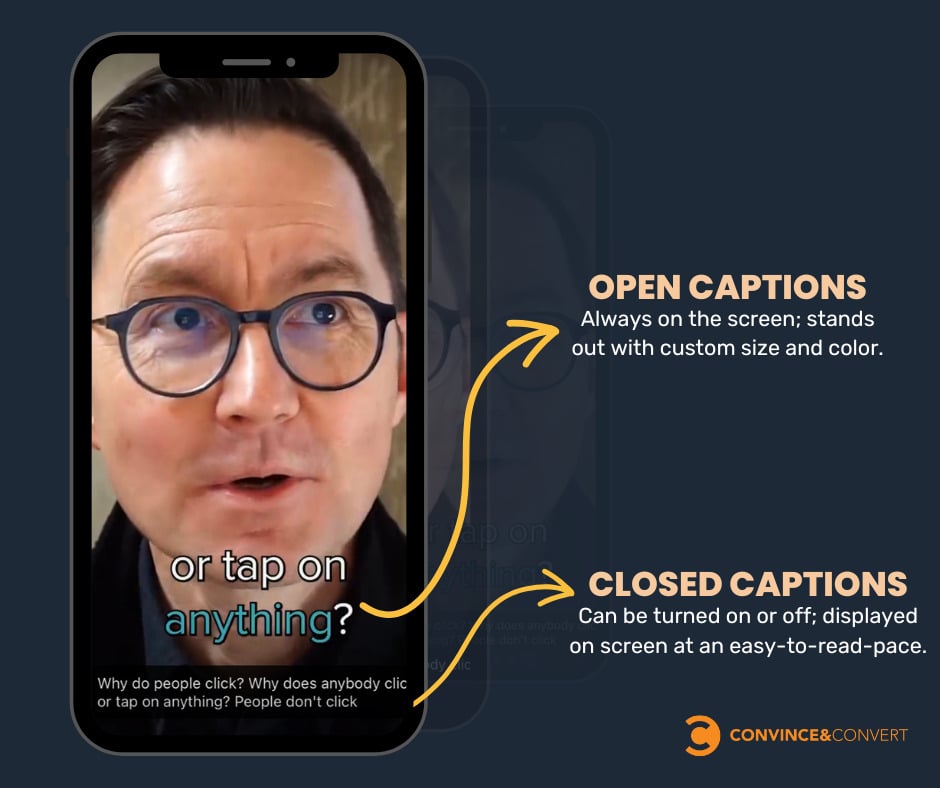![Put Your Video Caption Know-how to the Test [Cheat sheet included]](data:image/png;base64,iVBORw0KGgoAAAANSUhEUgAABkAAAAMgAQAAAABTu5P3AAAAAnRSTlMAAHaTzTgAAACySURBVBgZ7cExAQAAAMIg+6deCF9gAAAAAAAAAAAAAAAAAAAAAAAAAAAAAAAAAAAAAAAAAAAAAAAAAAAAAAAAAAAAAAAAAAAAAAAAAAAAAAAAAAAAAAAAAAAAAAAAAAAAAAAAAAAAAAAAAAAAAAAAAAAAAAAAAAAAAAAAAAAAAAAAAAAAAAAAAAAAAAAAAAAAAAAAAAAAAAAAAAAAAAAAAAAAAAAAAAAAAAAAAAAAAADALXQ+AAHo+CeFAAAAAElFTkSuQmCC) Pop quiz, hot shot.
Pop quiz, hot shot.
As consumer demand for online videos continues to climb, understanding how audiences interact with this type of content is a crucial consideration for digital marketers. Surprisingly, many people prefer the sound of silence when it comes to their viewing habits. A recent Preply survey found that 41% of Americans choose to have video captions turned on when watching online content, largely due to watching content in public settings.
Savvy marketers are catching on to this trend, and tapping into the “no sound” experience for videos on their corporate channels. To do this well, it is crucial to understand the ins and outs of video captions.
At Convince & Convert, we have partnered with hundreds of brands to produce social media content and strategic plans for channels like TikTok, YouTube, Instagram, Facebook, Twitter and LinkedIn. Unfortunately, we’ve found that captions are one piece of the process that is often overlooked by busy marketers, even though incorporating them into videos can make or break the success of a campaign.
How well do you stack up when it comes to knowing the ins and outs of video captions? The quiz below is based on real-life questions that have come up in our client projects. It’s okay if you draw a blank on the answers. We also provide a cheat sheet so you can wow your colleagues afterward by pretending you knew the answers all along.
41% of Americans choose to have video captions turned on when watching online content. Click To TweetQuiz instructions
Read the questions below, and reflect on your own level of knowledge and confidence in answering each one (don’t worry – there’s no time limit). For the overachievers out there, you can copy these questions onto a blank document and jot your answers down to compare to the cheat sheet. For everyone else: just have fun with it, and keep reading to learn something new.
- What is the difference between captions and subtitles?
- Do all of the major social media platforms provide automated captions?
- Which is better to use on social media videos: open captions or closed captions
- Do you have to include captions for online videos to be ADA compliant?
- Can closed captions boost your SEO efforts?
Video captions quiz cheat sheet
What is the difference between captions and subtitles?
First things first…there is a difference, and word choice matters. Getting this answer right is important to ensure that you can communicate effectively with your team, with vendors, and with your audience.
Captions are used to describe the audio components of a video to viewers who can not hear the sound. They indicate what is audibly happening in the video, including when music is playing, the words people are saying, and if there are any other sound effects taking place. There are different types of captions that can be used: open captions and closed captions.
Subtitles are used to help translate the video dialogue into a different language through written words on the screen. They are created with the assumption that the viewer can hear the audio in the video, but that they do not understand the language being spoken. They typically only translate spoken words and do not include other background sounds.

Do all of the major social media platforms automatically generate video captions?
Yes! It’s taken them years to get here, but now the biggest social media platforms all have the capability to automatically generate closed captions when you upload a video. This includes:
- TikTok
- YouTube
The not-so-subtle context here: Any video you upload to these channels should include captions. But don’t stop there. Be sure to review them first! The AI-generated text will save you a lot of time (no more manual transcriptions) but it is not always accurate. You’ll want to catch any mistakes before your viewers start blowing up your comments by spotting a hilariously mis-captioned quote.
Which is better to use on social media videos: open captions or closed captions?
Trick question! The answer here is that it depends on your brand and your goals for the video.
Open captions are when the words are “burned in” to the video file. The text always appears with the video; the viewer can not opt to turn them off. They give you more control over the look, style, and placement of your text. Some brands do a great job of using open captions to create eye-catching graphics that encourage people to stop scrolling their social feeds. They can even serve as an artistic way to incorporate text as part of the visual story.

The downsides to open captions: they are not great for multilingual audiences, as different versions of the video are needed for different languages. It is not as easy to create them or make changes to them once they have been added to the video. They are also not as accessible, since screen readers can’t access the text.
Conversely, closed captions are added to videos as a separate file, and they can be turned on or off by your audience. It gives viewers more control over how they want to engage with your content. It is also much easier to make adjustments, as you only have to edit text and not the actual video file.
Do you have to include captions for online videos to be ADA compliant?
For most organizations the answer to this is “yes”, but there are a few exceptions (ADA compliance does not apply to religious organizations nor to private clubs). Regardless of legality, it is always best practice to ensure that your video content is accessible for all audiences.
For context, the Americans with Disabilities Act is a US law that prevents discrimination against individuals with disabilities. It requires local and state governments, as well as businesses and nonprofits that serve the public, to communicate just as effectively to people with disabilities as those without. This includes providing accessible web content such as online videos.
ADA does not have clear and specific standards when it comes to video captions. Therefore, when preparing video content, a good strategy is to follow the rules set by the Federal Communications Commission. The FCC created these rules for television programming, but they are just as relevant for social channels. Captions need to be:
- Accurate: Captions match the spoken words in the dialogue and convey background noises and other sounds to the fullest extent possible.
- Synchronous: Captions coincide with their corresponding spoken words and sounds to the greatest extent possible and must be displayed on the screen at a speed that can be read by viewers.
- Complete: Captions run from the beginning to the end of the program to the fullest extent possible.
- Properly placed: Captions should not block other important visual content on the screen, overlap one another or run off the edge of the video screen.
Can video captions boost your SEO efforts?
Yes! This is another key factor to consider when deciding between using open vs. closed captions. Adding closed captions will allow search engines to crawl the text file and understand the context of your video in order to boost its ranking. Additionally, captions (open or closed) will also enable more viewers to understand your video, leading to a longer video watch time – something that algorithms highly favor.
Visit our office hours
How did you do? We grade on the honor system here. If you find that you are in need of some extra help when it comes to social media video strategy or production, we are here to help! Reach out to us at any time to learn more about partnering with our team of strategists.
![Put Your Video Caption Know-how to the Test [Cheat sheet included]](https://www.convinceandconvert.com/wp-content/uploads/2023/02/Put-Your-Video-Caption-Know-how-to-the-Test-Cheat-sheet-included.png) Pop quiz, hot shot.
Pop quiz, hot shot.
